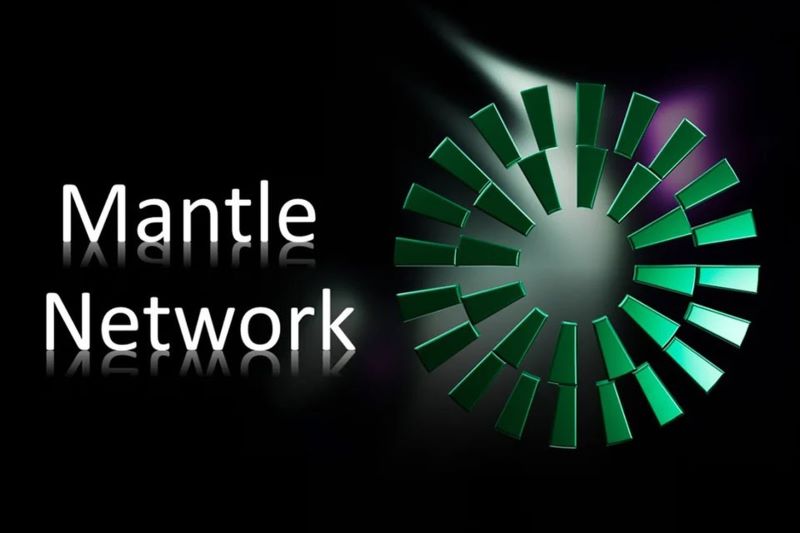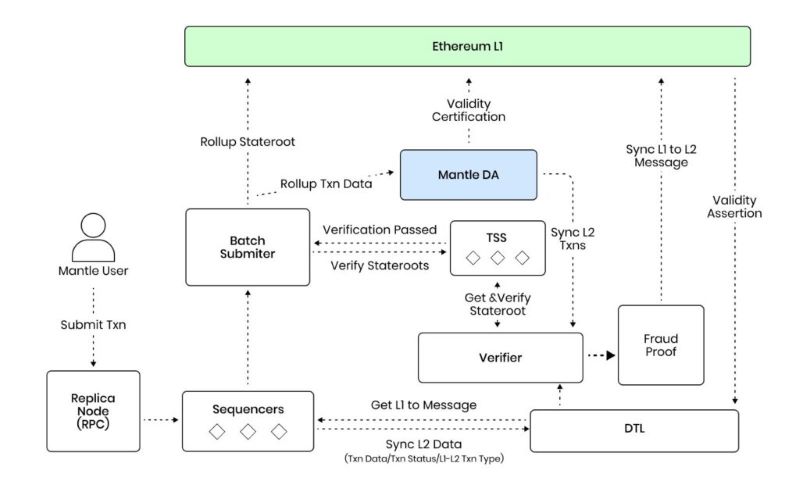Mantle, formerly known as BitDAO, is a leading project in the decentralized finance (DeFi) space, backed by the prominent crypto exchange Bybit. Evolving from one of the largest decentralized autonomous organizations (DAOs), Mantle continues to build on BitDAO’s legacy by introducing Mantle Network, a sophisticated Layer 2 (L2) blockchain solution designed to enhance the performance of decentralized applications (dApps) on Ethereum.
What is Mantle Network?
At its core, Mantle Network is a Layer 2 blockchain built on top of Ethereum. Leveraging Optimistic Rollups, Mantle aims to deliver increased transaction throughput, reduced costs, and enhanced scalability while maintaining the robust security offered by Ethereum’s main chain.
Unlike traditional Layer 2 solutions, Mantle takes a modular architecture approach. This means that Mantle’s structure allows for specialized layers to independently manage execution, consensus, and data availability, enabling a more scalable and flexible ecosystem.
The Mantle Network Advantage
Mantle Network stands out by addressing several critical challenges in existing Layer 2 solutions:
- Reduced Fees: High gas fees on Ethereum have long been a barrier for users. Mantle employs a unique data storage method using EigenDA, significantly reducing costs for users by compressing transaction data.
- Increased Scalability: The traditional use of Ethereum’s data layer can constrain Layer 2 solutions. Mantle’s architecture ensures higher throughput by offloading data storage to Mantle DA, which handles data availability independently of Ethereum’s constraints.
- Improved Transaction Finality: Mantle eliminates the extended withdrawal periods commonly seen with Optimistic Rollups, where users must typically wait up to 7 days to move assets back to the main Ethereum chain.
In addition to its Layer 2 functionality, Mantle also introduces Liquid Staking Derivatives (LSD). Through Mantle, users can stake ETH on the Ethereum network and receive mntETH tokens, which can be utilized within Mantle’s ecosystem. This process allows stakers to earn rewards such as Miner Extractable Value (MEV) and network fees while still actively participating in the ecosystem.
Technical Architecture of Mantle Network
Mantle Network’s modular architecture enables it to operate efficiently and securely across multiple layers. Here’s a closer look at its key components:
- Execution Layer: This layer provides an environment fully compatible with the Ethereum Virtual Machine (EVM), allowing developers to run dApps and smart contracts seamlessly.
- Consensus & Settlement: Transactions on Mantle are ultimately settled on Ethereum Layer 1 (L1), leveraging Ethereum’s battle-tested security mechanisms.
- Data Availability Layer: Mantle employs Mantle DA for data availability. Built on EigenDA and in collaboration with EigenLayer, Mantle ensures that all transaction data remains accessible and verifiable without burdening the Ethereum network.
Key Participants in Mantle DA:
- Operators: These are network participants who stake assets as collateral and are responsible for storing and validating data blocks. Their signatures ensure the data is reliable and secure.
- Dispersers: They handle the encryption and distribution of data across the network, ensuring that operators receive and verify the data.
- Challengers: These actors play a critical role in maintaining network integrity by challenging invalid data or behaviors, ensuring bad actors are penalized.
- Smart Contracts: A suite of smart contracts on Ethereum ensures that all data adheres to the protocol’s rules, including mechanisms for fraud proofs and data verification.
Operational Flow of Mantle Network
Mantle Network’s transaction flow is designed to ensure efficiency, security, and reliability. When users submit transactions, they are collected by the Sequencer, who groups them into blocks and publishes them on Ethereum. The process involves several stages:
- Sequencer Packaging: The Sequencer packages user transactions into blocks and syncs them via Mantle’s Data Transport Layer (DTL).
- TSS Validation: Transactions are verified by Threshold Signature Scheme (TSS) nodes, ensuring their authenticity before being finalized on Ethereum’s Layer 1.
- Rollup Submission: Once validated, these transactions are submitted to Ethereum’s State Commitment Chain (SCC) contract for final settlement.
- Data Storage: The complete transaction data is stored within Mantle DA, where it remains available for future audits or fraud proof challenges.
By separating the data availability layer from Ethereum’s base layer, Mantle achieves reduced costs and enhanced throughput, all while maintaining the highest levels of security.
Key Features of Mantle Network
Mantle’s unique design and approach result in several notable advantages:
- Ethereum Security: All Layer 2 operations on Mantle are ultimately verified and secured by Ethereum’s validators, ensuring trust and integrity.
- Developer-Friendly: Mantle supports all major Ethereum development tools and frameworks, such as Solidity, Vyper, Truffle, and Hardhat, making it accessible for developers looking to build on Ethereum.
- Significant Gas Fee Reduction: By compressing transaction data and utilizing its modular architecture, Mantle lowers gas fees by over 80% compared to standard Ethereum transactions.
- Higher Throughput: Mantle can process up to 500 transactions per second (TPS), compared to Ethereum’s 12 TPS. Additionally, customizable security settings allow for near real-time transaction finality, with confirmation times as low as 10 milliseconds.
Strategic Merger with BitDAO
In May 2024, Mantle Network and BitDAO officially merged, marking a significant milestone in the blockchain industry. This merger followed the approval of the BIP 21 proposal, which brought together BitDAO’s financial governance and Mantle’s technical prowess.
As part of this merger, Mantle Network gained access to BitDAO’s substantial treasury, which includes over $300 million in stablecoins and 270,000 ETH, equivalent to approximately $485 million. This financial support will play a critical role in Mantle’s ongoing development and expansion efforts.
Tokenomics & Governance
Mantle Network’s native token, MNT, is integral to the network’s operation and governance. Key details include:
- Token Name: Mantle Network (MNT)
- Blockchain: Ethereum (ERC-20)
- Total Supply: 6.2 billion tokens
MNT holders can participate in governance decisions, ensuring that the network remains decentralized and community-driven. Additionally, MNT tokens are used for transaction fees and as collateral by Node Operators to secure the network.
Mantle Network represents a major step forward in blockchain technology, offering a highly scalable, cost-effective, and secure solution for dApps built on Ethereum. With its modular architecture, integration of Optimistic Rollups, and support from BitDAO, Mantle is well-positioned to play a pivotal role in the future of decentralized finance and the broader blockchain ecosystem.
For further information, visit the website.


